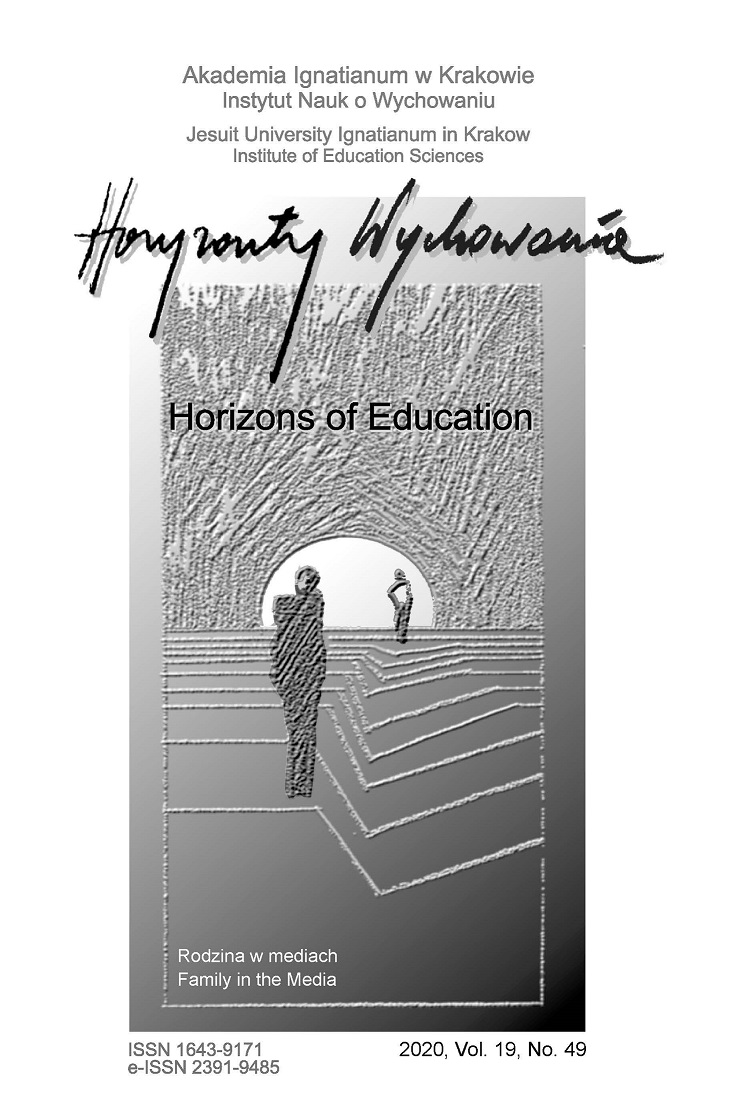Rodzina skonstruowana na potrzeby perswazji w świetle badań reklamy i znaków towarowych
Abstrakt
CEL NAUKOWY: Celem artykułu jest ukazanie zależności pomiędzy obrazem rodziny w języku a działaniami kreacyjnymi w reklamie oraz przedstawienie aktualnego obrazu rodziny w działaniach reklamowych na podstawie analizy znaków towarowych i badań reklamy telewizyjnej.
PROBLEM I METODY BADAWCZE: Problemem badawczym jest ukazanie sposobów przedstawiania rodziny w reklamie przy równoczesnym wskazaniu przyczyn dokonywanych na potrzeby perswazji wyborów. Spośród metod badawczych zastosowano analizę danych słownikowych, analizę korpusową, badania potencjału perswazyjnego znaków, ramowanie (frame semantics) oraz pomocniczo metodologię językowego obrazu świata.
PROCES WYWODU: Wywód składa się z trzech części. Celem pierwszej części jest ukazanie specyfiki słowa i pojęcia rodziny w języku w świetle badań korpusowych i słownikowych, które ukazują przyczyny sposobów przedstawiania rodziny w reklamie. W dalszej części rozważań ukazano sposoby eksploatacji pojęcia rodziny w projektowaniu znaków towarowych. Trzecia część wywodu skupia się na zaprezentowaniu specyfiki prezentacji rodziny i jej modelu w reklamie komercyjnej.
WYNIKI ANALIZY NAUKOWEJ: Przeprowadzone badania dowodzą, że sposób przedstawienia rodziny w reklamie telewizyjnej odpowiada najbardziej popularnym słownikowym i korpusowym znaczeniom, które uzasadniają wybór rodziny nuklearnej w reklamie w zastępstwie rodziny wielopokoleniowej. Obraz rodziny w spotach i znakach towarowych służy realizacji funkcji fatycznej, wartościowaniu produktów, oferty lub producenta i wykorzystuje heurystyki, służąc przyjęciu przez odbiorcę sądów wyrażanych w komunikatach.
WNIOSKI, INNOWACJE, REKOMENDACJE: Obraz rodziny w znakach towarowych i reklamach telewizyjnych jest mniej zróżnicowany w zestawieniu z przekazami medialnymi o innej niż perswazyjna funkcji. Różni się także od obrazu rodziny w reklamach właściwych dla przestrzeni Internetu. Wykorzystanie tradycyjnego znaczenia rodziny utrwalonego w języku i myśleniu potocznym jest modyfikowane w zależności od potrzeb zaplanowanego adresata (matki, ojca, ich potomstwa), co otwiera dyskusję nad zmieniającymi się wzorcami męskości, kobiecości i dziecięcości.
Bibliografia
Badanie Kids' Power (2016). http://wyborcza.biz/pieniadzeekstra/1,134263,20953980,dzieci-decyduja-o-zakupach-nachodzi-pokolenie-jednorozcow.html (dostęp: 19.12.2019).
Bierca, M. (2019). Nowe wzory ojcostwa w Polsce. Warszawa: Wydawnictwo Borgis.
Bończyk, E. (2018). Kulturowe kody reklamy. Świat znaczeń w reklamie z perspektywy socjalizacji. Katowice: Wydawnictwo Uniwersytetu Śląskiego.
Boryś, W. (2005). Słownik etymologiczny języka polskiego. Kraków: Wydawnictwo Literackie Sp. z o.o.
CBOS (2019). Preferowane i realizowane modele życia rodzinnego. Rodzina – jej znaczenie i rozumienie. Komunikat z badań nr 46, 6.
Dubisz, S. (red.). (2003). Uniwersalny słownik języka polskiego, t. 3. Warszawa: Wydawnictwo Naukowe PWN.
Dubisz, S. (red.). (2018), Wielki słownik języka polskiego. Warszawa: PWN, t. 4.
Dybalska, R. (1998). Pan Józef to lubi. Aida media, 8, 51.
Fillmore, C. (1976). Frame semantics and the nature of language. Annals of the New York Academy of Sciences, 20, 25.
Fillmore, C. (1982), Frame semantics (red.), Linguistics in the Morning Calm: Selected Papers from SICOL-1981. Seoul: Hanshin, 111.
Handke, K. (2008), Socjologia języka, Warszawa: Wydawnictwo Naukowe PWN.
Jachnis A, Terelak J. (1998), Psychologia konsumenta i reklamy, Bydgoszcz: BRANTA
Karta Praw Rodziny (1983), L'Osservatore Romano" 10 – wersja polska http://www.srk.opoka.org.pl/srk/srk_pliki/karta.htm (dostęp: 19.12.2019).
Konstytucja Rzeczypospolitej Polskiej z dnia 2 kwietnia 1997 roku, Dz.U. 1997 Nr 78, poz. 483 ze zm.
Kreja, B. (2001), Mówię więc jestem, Gdańsk: Wydawnictwo Uniwersytetu Gdańskiego.
Kurcz, I. (2000). Psychologia języka i komunikacji, Warszawa: Wydawnictwo Naukowe SCHOLAR.
Leszczuk-Fiedziukiewicz, A. (2004). Rodzina czyli inwestycja z zyskiem. Mechanizmy perswazyjne w telewizyjnej reklamie rodzinnej. W: R. Garpiela, K. Leszczyńska (red.), Sztuka perswazji. Socjologiczne, psychologiczne i lingwistyczne uwarunkowania przekazu perswazyjnego. Kraków: NOMOS.
Lisowska-Magdziarz, M. (2012). Feniksy, łabędzie, motyle. Media i kultura transformacji. Kraków: Wydawnictwo Uniwersytetu Jagiellońskiego.
Markowski, A. (red.) (2007). Słownik Poprawnej Polszczyzny. Warszawa: PWN.
Mindshare (2018–2019) Decyzyjność zakupowa w Polsce. Opis ilościowego badania rynku, https://www.wirtualnemedia.pl/artykul/w-polskich-domach-decyzje-zakupowe-podejmuja-kobiety(dostęp: 10.12.2019).
Mindshare Huddle For Good (2018), www.wirtualnemedia.pl/artykul/stosunek-do-reklam-polakow-raport (dostęp 30.12.2019).
Narodowy Korpus Języka Polskiego, www.nkjp.uni.lodz.pl (dostęp: 10.12.2019).
Olczyk, D. (2017). Dzieciocentryzm, czyli jak dzieci wpływają na decyzje zakupowe rodziców?, https://nowymarketing.pl/a/16178,dzieciocentryzm-czyli-jak-dzieci-wplywaja-na-decyzje-zakupowe-rodzicow (dostęp 10.01.2020).
Oparski, K. (1998). Polowanie na mężczyznę, „Aida media” 9, 52.
Ryłko-Kurpiewska, A. (2016). Reklama jako sztuka powtórzeń. Gdynia: Novae Res.
Słowosieć, http://plwordnet.pwr.wroc.pl/wordnet/cf80b744-5d16-11e9-a56b-633271de9c77 (dostęp: 5.01.2020).
Szczęsna, E. (2001). Poetyka reklamy. Warszawa: Wydawnictwo Naukowe PWN.
Szymczak, J. (2002), Definicje rodziny. Studia nad Rodziną 2(11), 163.
Szymczak, M. (1981). Słownik języka polskiego. Warszawa: PWN, t. 3.
Urząd Patentowy RP. Wyszukiwarka dla znaków towarowych, regservtd.uprp.pl/register/advancedSearch?searchMode=advanced&pn=&ap=&fd=&pd=&prd=&pa=&re=&in=&pr=&ti=rodzina&op=&ic= (dostęp: 19.12.2019).
Ustawa z dnia 25 lutego 1964 r. – Kodeks rodzinny i opiekuńczy, Dz.U. z 2015 r., poz. 2082, art. 146.
Zboralski, M. (1995). Nomen omen, czyli jak nazwać firmę i produkt. Warszawa: Business Press.
Żmigrodzki, P. (red.). (2018). Wielki słownik języka polskiego, https://wsjp.pl/index.php?id_hasla=12839&id_znaczenia=4316275&l=22&ind=0 (dostęp: 10.12.2019).
Copyright (c) 2020 Anna Ryłko-Kurpiewska

Utwór dostępny jest na licencji Creative Commons Uznanie autorstwa – Bez utworów zależnych 4.0 Międzynarodowe.
Uwagi dotyczące praw autorskich
Autorzy publikujący w tym czasopiśmie wyrażają zgodę na następując warunki:
- Autorzy zachowują prawa autorskie, przyznając czasopismu prawo do pierwszej publikacji swojego tekstu jednocześnie zarejestrowanego pod numerem licencji CC BY-ND, która pozwala innym na korzystanie z tego tekstu z uznaniem autorstwa tekstu oraz pierwotnej publikacji w tym czasopiśmie.
- Autorzy proszeni są o nawiązywanie odrębnych, dodatkowych porozumień wynikających z umowy, dotyczących dystrybucji opublikowanej w czasopiśmie wersji tekstu nie na prawach wyłączności (np. opublikowanie go w repozytorium instytucji lub w innym czasopiśmie), z potwierdzeniem pierwszej publikacji w tym czasopiśmie.
Wyraża się zgodę i zachęca autorów do publikacji ich tekstu w Internecie (np. w repozytorium instytucji lub na jej stronie internetowej) przed lub podczas procesu składania tekstu jako, że może to prowadzić do korzystnych wymian oraz wcześniejszego i większego cytowania opublikowanego tekstu (Patrz The Effect of Open Access). Zalecamy wykorzystanie dowolnego portalu stowarzyszeń badawczych z niżej wymienionych:





